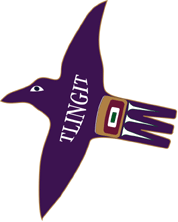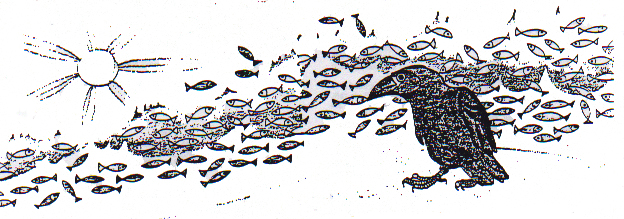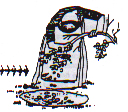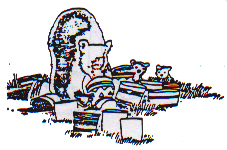 Tlingit Indians of Southeastern Alaska Tlingit Indians of Southeastern Alaska
Section 5
3 days (1 week)
WRAP UP
| CONCEPTS: |
CULTURAL CHANGE, MATERIAL CULTURE, POTLATCH, CLAN STRUCTURE |
OBJECTIVES
- Students will read about and see some of the changes
in Lingit Aanee since Kahtahah's time.
- Students will view and compare Tlingit material culture
with contemporary urban and with traditional Athabascan material culture,
at the museum.
- Students will exhibit an understanding of the following
aspects of potlatches: clan crest display, gift giving, hosting the opposite
moiety (optional).
|
MATERIALS
- Kahtahah
- Kwakiutl Family filmstrip if available
- Community Profiles of Southeast Alaska
- Photographs of contemporary Southeast Alaska
- Enrichment: audiovisuals on change through the
years (see p. 153 for a list)
- Clan banners or hangings
|
PREPARATION
- Obtain audio-visual materials on contemporary Southeastern
Alaska, as desired.
- Obtain any art supplies necessary for clan presentations.
- Confirm museum visit time.
|
ACTIVITIES
| DAY 1 |
1. Read and discuss pp. 20-23,
37-43, and 54-57 in Kahtahah.
2. View materials on or discuss modern days in Lingit
Aanee
LANGUAGE ARTS: Writing
3. Prepare for museum visit
|
| DAY 2 |
4. Museum visit |
| DAY 3 |
5. Clan presentations and/or potlatch |
Section 5: WRAP UP
DAY l
CONCEPT: CULTURAL CHANGE
KAHTAHAH
Read at least pp. 20-23, 37-43, and 54-57 in Kahtahah
many teachers choose to finish the entire book. Note the
references to trade on these pages.

How Raven
Fooled Seagull and
Crane
 One
day Snook received word that a large canoe was lying in the outer bay, waiting
for the tide to rise so it could go through the pass. One
day Snook received word that a large canoe was lying in the outer bay, waiting
for the tide to rise so it could go through the pass.
"They must be the people from the
other side. It's time for herring eggs." said Snook.
The big canoe come slowly into the salt
lake when the tide had ceased to roar through the rocky pass and the waters
ran slack. In it was a trading party from the seaward side of the big island
where the herring ran thick in the spring. They wanted to get eulachon oil and
brought many dried herring eggs to trade. Snook had plenty of eulachon oil so
he took all the herring eggs the visitors brought, and they went happily away.
When the herring swarmed in from the ocean,
these westward people had cut down hemlock trees to put into the water for the
spawning fish. Millions of tiny white eggs were caught on the branches, which
were then taken out to dry in the wind and the sun.
To eat the eggs, the branches were soaked
in water until the eggs slipped off. Then the eggs were boiled a very short
time until they were like transparent seed pearls. Kahtahah liked to eat herring
eggs because of the fresh salty taste and the crackly noise the made between
her teeth.
The chief had been right when he said
that there would be no deer near the summer camp because the wolves had driven
them away. Not once all summer long did the hunters see a deer track along the
beaches and the creeks. Whenever they needed venison, the young men had to hunt
across the channel on another island where there were no wolves. The meat that
was not used at once was cut into thin stripe and dried and smoked. The tallow
was mixed with berries and poured into skin bags for winter use, and the skins
were tanned and bleached. sometimes as white as the blossoms of the crab apple
trees, for clothing and moccasins. The old women sat constantly at the stretching
frames, scraping and softening the skins with their dull bone knives.
Kahtahah, already a skillful seamstress,
was making herself a white deerskin dress with bead trimmings. She had a shiny
needle that had belonged to her real mother and some bright beads that Snook
had traded for furs from the Hudson's Boy Company. As Kahtahah sewed, she watched
two old black ravens strutting back and forth an the ridge of the smokehouse,
talking to each other.
"They sound like two old men,"
she said. "I wonder if they are talking about the salmon in the smokehouse.
Ravens are greedy, but they are lazy, too. Mother, tell me the story about how
the raven tricked the sea gull and the crane." She told the following story
as they sewed.
"Raven walked along the beach one
day, hungry. The water bubbled with a big school of herring, but Raven, though
a fish eater, was no fisherman, and he had to find a way to get a herring.
He
looked around and saw a crane standing on one leg in the water, fishing, and
a sea gull that had just lighted on a rock after swallowing a nice, fat herring.
He could see the big bulge that the herring made on the side of the sea gull's
breast and said to himself. 'I must have that herring or I'll die.'
"He walked past Crane and spoke
to him, and then strolled over to Seagull. Returning to Crane, he said. 'I
don't
like to tell you this, but I feel that I ought to because I am your friend.
You saw me talking with Seagull. He called you an ugly, long-legged brute
and
said that your ancestors were slaves.' Crane did not answer.
"So Raven walked over to Seagull
and asked. 'You saw me talking to Crane just now? I really don't like to
do
this, but I feel that I should because I am your friend. That Crane called
you some very insulting names; said you were a no-account, a common thing
of low
birth, and that your grandmother was a witch.' Seagull said nothing.
"Raven then walked back to Crane
and whispered. 'I think I had better warn you that Seagull just told me that
he was coming over here to fight you. If he does, just remember that his
weak
spot is his chest. Kick his chest hard and you will win the fight.' Crane looked
over at Seagull, who acted restless. He felt grateful to Raven.
"Raven then went to Seagull. 'I
wonder.' he asked. 'what is the matter with Crane? He seemed so angry at
you, kept calling
you insulting names, and just now told me that he was coming over here to give
you a beating. You had better not wait. See him looking at you? You had better
start right out and if he tries to kick you, stick your chest at him and
he
can't hurt you. You go at him hard with your chest.' Just then Crane shifted
from one foot to the other. 'See that? See that?' Raven exclaimed. 'He is
planning
to come at you. You had better start at him right now.'
"So Seagull and Crane started toward
each other, grateful that their good friend Raven had warned them and prepared
them for victory. They walked faster and glared at each other as they approached.
Both fairly flew the last few feet. Remembering the good advice Raven had
given
him. Crane raised his foot and kicked at Seagull's chest with all his might,
and Seagull, having been warned by his good friend Raven, promptly presented
his chest to receive the blow. Crane struck, and the herring popped out.
Raven
caught it before it fell into the water, and flew off chuckling. Crane and
Seagull realized that Raven had told them a bunch of lies and stopped fighting.
When
our people hear stories that make them feel angry toward others they say. 'Perhaps
Raven is carrying tales to Seagull and Crane once more. Everybody understands
what is meant."
Kahtahah laughed. "Raven was always
playing tricks on people, wasn't he, mother?"
"Yes," she answered. "but Raven
was kind to us, too."
Refer to Appendix H for a collection
of Raven stories.
Only the top half of page 23 is to be read.

Seals
The hair seals had a rookery on a small
rocky island without trees or small bushes out in the channel near the mouth
of the bay. The seals talked together a lot - the old ones with hoarse grunts
and growls and the young ones with shrill squeals and whistles - and Kahtahah
used to pretend she could understand what they were saying to each other. Hunters
had to be skillful to get a seal at the rookery, even though they came close
in a small canoe and imitated their growls, because the seals were very sensitive
and dove into the water, leaving the rock bare, at the slightest disturbance.
The Northwest Coast Study Prints (UN 639), studied during
the next section, contain a print of a spruce root basket (Print #1). Show the
print to the students after they have read this chapter in Kahtahah.
 Bears
Like Bears
Like
Blueberries
The women and children had spent all morning
picking blueberries from the low bushes at the edge of the forest. To pick the
berries, each person placed a broad, flat basket on the ground under a bush
and pulled down the branches, stripping them bare of both leaves and berries.
She then shook the basket and blew all of the little sticks and leaves away,
leaving the clean berries, which she emptied into a deep basket under the trees.
When Kahtahah carried her deep basket
to the edge of the stream where many others stood ready for the canoe trip back
to camp, she saw a mother bear and her two round, fat cubs tipping over the
baskets, scooping the berries into their mouths, pawful after pawful.
 "Look,
Mother! Look, Tsoonkla! Oh, look, everybody! The bad wicked bears are spoiling
our berries!" All of the women came running to her call. Kahtahah was
angry and wanted to run out and chase the bears away, but her foster mother
pulled
her back. "Look,
Mother! Look, Tsoonkla! Oh, look, everybody! The bad wicked bears are spoiling
our berries!" All of the women came running to her call. Kahtahah was
angry and wanted to run out and chase the bears away, but her foster mother
pulled
her back.
"Be quiet!" she warned. "Don't
you see that it's a mother bear? We must be careful because even a black
bear
mother will fight for her cubs."
"But our berries will be gone!" cried
the children.
"And our baskets, too!" the women
exclaimed as the two cubs began to pull on the same basket. Both hung on
tenaciously,
squealing and growling. The mother bear, alerted by the noise, reached out
with her big paw, and with one blow ripped the basket in two. The little
bears tumbled
over backward, but recovering, sat up on their haunches and looked at the other
baskets. They rolled their naughty little eyes at each other, and as if propelled
by one thought, scrambled to the other baskets, and imitating their mother,
ripped them to pieces right and left.
Remembering the hunting stories her foster
father had told her. Kahtahah said, "Come on. We must get the wind behind
us. Snook told me that's the way to frighten black bears away. When they
get
our scent, the mother bear will tell her cubs to run into the woods."
Everyone stepped back into the trees and
ran quickly over the soft moss to the other side where the wind would carry
their smell to the bears. They peeped out from behind the tree trunks to watch.

The mother bear lifted her nose, sniffed
the gentle breeze and thought. "Man-smell." Lumbering over to her cubs,
she slapped them away from their game of ripping berry baskets, and they
disappeared
into the forest so quickly that Kahtahah could not believe her eyes.
After a few seconds the women and children
hurried across the meadow to the stream. Blueberries, mashed and spoiled, were
scattered everywhere on the grass, and the baskets were badly torn.
"Ai-ee, aa-ee, those bad bears."
sighed Kahtahah's mother. "Now we'll have to weave baskets all winter
to replace them."
"I'm sorry I didn't eat every berry
I picked." Tsoonkla grumbled. Kahtahah looked at Tsoonkla's berry-stained lips
and teeth, and couldn't help laughing. "it's plain that you ate a lot at
that." she answered.
"Those little black bears looked
so cute when they tumbled over backward," Tsoonkla whispered. "I wish
we could have them for pets."
Kahtahah answered, "It would be like
the deer we had once. You remember how sweet it was when it was a little
spotted
fawn, but when its horns got big it tried to kill that boy who teased it a
[lot]. Snook said we should let it go before anyone was hurt. Snook would
have had
to make big presents if someone had been hurt. I cried under my blanket when
they took my deer into the woods."
They picked up the baskets that could be
mended, each woman hoping that she had enough spruce roots drying to make all
the new baskets she would need.
Remind students of the reading at the beginning of this unit on where
the Tlingits came from (Chapter 1 in The Tlingit World).
How
the Stikheenquan Came Down the River was not available at the time of converting
this resource for educational online use.
Summer Comes to
an End was not available at the time of converting this resource for educational
online use.
Section 5: Wrap UP
LANGUAGE ARTS
LANGUAGE ARTS
WRITING
- Discuss what passages in the book Kahtahah indicate
some of the changes that were occurring in Tlingit culture during Kahtahah's
childhood.
- Have students write a poem about how Kahtahah felt when
she saw- the Eagle canoe in the New York museuma Put the poem in the student
folders or notebooks.
- Have students write or tell about a time when they have
felt homesick about a place or time in their pasts.
UPDATE ON SOUTHEASTERN ALASKA
There are several resources you could use to give students a
vivid impression of life in Southeastern Alaska today. For instance:
1. RESOURCE PERSON
Invite a Tlingit resource person to your class. Ask him or her
to prepare a slide show or talk about how life (and family structure in particular)
have changed in the last 100 years.
2. FILMSTRIP
Show the class A Kwakiutl Family (a filmstrip from SVE
series Six Native American Families). Although Kwakiutls live in British
Colombia, their culture is considered part of the Northwest Coast area and is
similar enough to modern Tlingit life so that students can draw comparisons
and understand some of the changes since Kahtahah's day. List the ways the Kwakiutls
earn a living today. Compare them with the ways the Tlingits earned a living
in Kahtahah's day.
3. COMMUNITY PROFILES
Refer to Conniiunity Profiles for information on the current
economic status of Southeastern communities. Students could do individual research
or the profiles could be used for their photographs. Relate each picture with
the location of the community on the Language or Tongass Forest map.
4. PHOTOGRAPHS
Cut out and laminate photographs of modern Southeastern Alaska
which you have obtained from magazines. Discuss the photographs with the students.
See also Volume 5 of the Alaska Geographic Series (see Appendix F).
5. ENRICHMENT: FILMS AND VIDEOTAPES
Other resources pertinent to the topic of cultural change and
contained in the Anchorage School District's AVS Center are:
F 2813 The Choice Is Ours
F 3665 Tlingit Ani
F 4791 American Indians: Yesterday and Today
UN 521 Time of Change
UN 647 Alaska Natives at the Turn of the Century
UN 674 The Way it is Today
DISCUSSION
Discuss how Kahtahah's life was different from the students'
lives because of her clan and moiety memberships. Ask students to think of all
the ways that Kahtahahs life was effected by her family. A review of the clan
rules might be helpful in this discussion. Examples might be:
1. The work and play Kahtahah was allowed to do
2. Whom Kahtahah was allowed to marry
3. Where she lived
4. Whom she learned from
5. How she spent her summers
6. Whom she felt closest to
7. The stories she learned
Have students consider to what extent their own families determine
their lives, using the above seven topics as examples.
Extend the discussion to other cultures your class has studied.
MUSEUM PREPARATION
Prepare your class for its visit to the museum. Review the following
ideas with your students:
1. Crest designs on clan-owned objects
2. Subsistence implements and their uses
3. Abundance of wood and wood-products
4. The sea orientation of Tlingit objects
ENRICHMENT: Duplicate for students or read to them the following
fictionalized, but historically accurate story by Barbara Bernard (4th grade
teacher, Ptarmigan School), before your museum visit.
Tlingit Spruce Root Basketry by Barbara Bernard
When I was six I began helping my mother and the
other women of the village in the long process of basket-making. I was very
excited to be allowed to go that first time. One morning, after the frost had
left the soil , I woke to hear mother clattering around getting
ready to go gathering. After we had eaten a bit of fish and packed our lunches
we were ready to go. Everyone, grandmothers, aunts, cousins and friends met
down at the beach to load the canoes. Our uncle came also to paddle us across
our cove. I knew uncle would be staying with us when we collected the roots.
He would be watching for bears.
When we arrived at the other side of the cove grandma
led the way. She stopped at a spot where the ground was sandy around the spruce
trees. This meant that the roots would be close to the surface and unentangled.
Grandma finally settled on a tree that was between one to two feet around with
reddish colored bark. Once she had pointed out the tree the women gathered around
and started prodding at the roots to loosen them. They knew that if they had
gotten a good tree the roots would be very long and bendable. After each root
was loosened my mother and aunt pulled and lifted it out of the dirt, cleaned
it off, coiled it and put it in a basket.
When we got home with a big load of roots, we stirred
the fire right away so that we could steam the coils over the fire. I got to
help strip the bark off of them. We used a tool that was a stick with a notch
cut off the top. My aunt would hold the stick upright and I would pull the warm
root through the notch. The bark peeled off beautifully! Then we hung the coils
to season and dry them. It was usually a long time before we would get back
to making the roots into baskets. The coming summer would be the busiest time
of the year for us. We would go to fish camp, pick berries, and some days we
would collect eggs. Basketmaking just had to wait until fall.
After the days got shorter, mother began preparing to
weave. She brought the roots out from under the bench and set them in water.
When the roots were soft and workable they were split. An especiafly big root
was sometimes split as many as four times. Mother showed me how to tie the roots
into neat even bundles. We put all the bundles together, got a bowl of water,
and placed dyed grasses and ferns next to her spot by the fire. Now everything
was in place and mother was finally ready to weave. At first I just watched
Mother as she wove. Because I had been allowed to go along and collect the roots
I was especially interested in the batch of baskets that would be made from
those roots. I knew that Mother would let me try to make my own basket this
year if I wanted. I watched Mother for several days before I was ready to try.
Finally, one day I picked up a bundle of roots and began. I tried to do exactly
as I had seen. My basket took me many days. When I finished it the basket was
lopsided and wobbly, but my mother and grandmothers were pleased I had started
to learn. When I grew up I discovered that Mother had saved my first little
basket. I then showed it to my daughter when she began to learn to weave.
Baskets were used everywhere in our house! There were
baskets for cooking. Mother would put the meat in the basket and then drop hot
stones from the fire on the food, add water, cover the basket and in just a
short time we would have a delicious supper. Our small water-tight baskets were
used for drinking and carrying water. We also used baskets to haul things, for
gathering berries, roots and shell fish.
Baskets were not the only thing Mother would weave. She
and all the other women in our village made hats, meat bags, mats for the floor
and even a cradle for baby. But telling how we made all these things would be
another story!
Additional information about Tlingit Baskets:
| Colors -- |
Black - |
Burning
steeping in a mixture of hemlock bark alder bark
using the black mud from supher springs |
| |
Yellow - |
produced by steeping the materials in tree
moss or reindeer moss (lichen) |
| |
Red - |
urine was used to produce most shades of red |
| |
Blue/Green - |
boiling hemlock bark in urine and adding
copper oxide which had been scraped off of copper
rock
|
| |
Purplish black - |
dark blue blueberries |
Dyed grasses were woven into the baskets for decoration. Grasses
were gathered in the early summer before they were ripe. The grass was then
dipped in boiling water and spread out in the shade to dry slowly. After the
grass was sufficiently dry it was tied together in bundles and stored for later
use.
Decorations on Tlingit baskety were pictorial and represented
things found in nature. One feature was often chosen to represent an animal
or plant.
| An example: |
"The tail of the snow-tall" (Arctic Tern)
The saucy tail is a characteristic of this noisy little
bird.
|
Tlingit designs were handed down from
generation to generation, from mother to daughter.
Late 1800's to the present:
In the late 1800's traders brought pots and pans, cups and glasses,
pails and rugs which in turn changed the need for making baskets. Traders began
to encourage the women to make baskets for sale. As baskets became marketable,
shapes and ornamentation were simplified and the resulting baskets were smaller.
Most girls no longer learn to make baskets. There are only a
few Tlingit women still skilled in the art of weaving baskets. Presently, Tlingit
basketry is an object of beauty, rather than use.
Paul, Frances, Spruce Root Basketry of the Alaskan
Tlingit, U.S. Department of Interior 1944.
Cavana, V.V., "Alaska BAsketry", obtained from the
Anchorage Historical and Fine Arts Museum.
DAY 2
MUSEUM VISIT
DAY 3
CLASS/CLAN PRESENTATIONS OR POTLATCH
TABLE OF CONTENTS
MATERIALS LIST & GOALS
SECTION 1: Tlingit
Country
SECTION 2:
Clans
SECTION 3: Summer
Camp
SECTION 4: Tlingit
Economy: Surplus
SECTION 5: Wrap
Up
APPENDIX A: Brief
Description of Tlingit Culture
APPENDIX B: A Sample
Winter Clan House
APPENDIX C: Northwest
Coast Materials in ASD AVS Center
APPENDIX D: Juvenile
Literature on Northwest Coast Cultures
APPENDIX E: Art
Bibliography
APPENDIX F: Northwest
Coast Cultures Bibliography
APPENDIX G: Schools
Which Own Northwest Coast Study Prints
APPENDIX H: Raven
Stories (reprints)
APPENDIX I: Recorded
Versions of Clan Crest Stories
APPENDIX J: Some
Northwest Coast Art Activities
|